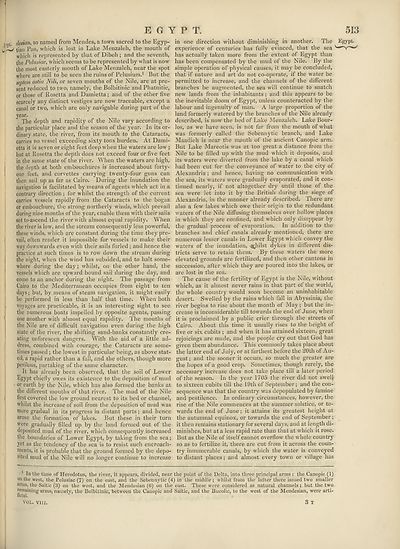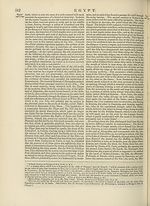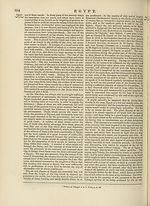Encyclopaedia Britannica > Volume 8, DIA-England
(523) Page 513
Download files
Complete book:
Individual page:
Thumbnail gallery: Grid view | List view

EGYPT.
513
j .pt, desian, so named from Mendes, a town sacred to the Egyp-
tian Pan, which is lost in Lake Menzaleh, the mouth of
which is represented by that of Dibeh; and the seventh,
the Pelusiac, which seems to be represented by what is now
the most easterly mouth of Lake Menzaleh, near the spot
where are still to be seen the ruins of Pelusium.1 But the
septem ostia Nili, or seven mouths of the Nile, are at pre¬
sent reduced to two, namely, the Bolbitinic and Phatnitic,
or those of Rosetta and Damietta; and of the other five
scarcely any distinct vestiges are now traceable, except a
canal or two, which are only navigable during part of the
year.
The depth and rapidity of the Nile vary according to
the particular place and the season of the year. In its or¬
dinary state, the river, from its mouth to the Cataracts,
carries no vessel exceeding sixty tons burden. At Dami¬
etta it is seven or eight feet deep when the waters are low ;
but at Rosetta the depth does not exceed four or five feet
in the same state of the river. When the waters are high,
the depth at both embouchures is increased about forty-
one feet, and corvettes carrying twenty-four guns can
then sail up as far as Cairo. During the inundation the
navigation is facilitated by means of agents which act in a
contrary direction ; for whilst the strength of the current
carries vessels rapidly from the Cataracts to the bogaz
or embouchure, the strong northerly winds, which prevail
during nine months of the year, enable them with their sails
set to ascend the river with almost equal rapidity. When
the river is low7, and the stream consequently less powerful,
these winds, which are constant during the time they pre¬
vail, often render it impossible for vessels to make their
way downwards even with their sails furled; and hence the
practice at such times is to row down the stream during
the night, when the wind has subsided, and to halt some¬
where during the day; whilst, on the other hand, the
vessels which are upward bound sail during the day, and
come to an anchor during the night. The passage from
Cairo to the Mediterranean occupies from eight to ten
days; but, by means of steam navigation, it might easily
be performed in less than half that time. When both
voyages are practicable, it is an interesting sight to see
the numerous boats impelled by opposite agents, passing
one another with almost equal rapidity. The mouths of
the Nile are of difficult navigation even during the high
state of the river, the shifting sand-banks constantly cre¬
ating unforeseen dangers. With the aid of a little ad¬
dress, combined with courage, the Cataracts are some¬
times passed; the lowest in particular being, as above stat¬
ed, a rapid rather than a fall, and the others, though more
perilous, partaking of the same character.
It has already been observed, that the soil of Lower
Egypt chiefly owes its existence to the deposition of mud
or earth by the Nile, which has also formed the banks at
the different mouths of that river. The mud of the Nile
first covered the low ground nearest to its bed or channel,
whilst the increase of soil from the deposition of mud was
more gradual in its progress in distant parts; and hence
arose the formation of lakes. But these in their turn
were gradually filled up by the land formed out of the
deposited mud of the river, which consequently increased
the boundaries of Lower Egypt, by taking from the sea;
yet as the tendency of the sea is to resist such encroach¬
ments, it is probable that the ground formed by the depo¬
sited mud of the Nile will no longer continue to increase
in one direction without diminishing in another. The
experience of centuries has fully evinced, that the sea
has actually taken more from the extent of Egypt than
has been compensated by the mud of the Nile. By the
simple operation of physical causes, it may be concluded,
that if nature and art do not co-operate, if the water be
permitted to increase, and the channels of the different
branches be augmented, the sea will continue to snatch
new lands from the inhabitants ; and this appears to be
the inevitable doom of Egypt, unless counteracted by the
labour and ingenuity of man. A large proportion of the
land formerly watered by the branches of the Nile already
described, is now the bed of Lake Menzaleh. Lake Bour-
los, as we have seen, is not far from the mouth of what
was formerly called the Sebennytic branch, and Lake
Maadieh is near the mouth of the ancient Canopic arm.
But Lake Mareotis was at too great a distance from the
Nile to be filled up with the mud which it deposits, and
its waters were diverted from the lake by a canal which
had been cut for the conveyance of water to the city ol
Alexandria ; and hence, having no communication with
the sea, its waters were gradually evaporated, and it con¬
tinued nearly, if not altogether dry until those of the
sea were let into it by the British during the siege of
Alexandria, in the manner already described. There are
also a few lakes which owe their origin to the redundant
waters of the Nile diffusing themselves over hollow places
in which they are confined, and which only disappear by
the gradual process of evaporation. In addition to the
branches and chief canals already mentioned, there are
numerous lesser canals in Lower Egypt which convey the
waters of the inundation, s^hilst dykes in different dis¬
tricts serve to retain them. By these waters the more
elevated grounds are fertilized, and then other cantons in
succession, after which they are poured into the lakes, or
are lost in the sea.
The cause of the fertility of Egypt is the Nile, without
which, as it almost never rains in that part of the world,
the whole country would soon become an uninhabitable
desert. Swelled by the rains which fall in Abyssinia, the
river begins to rise about the month of May ; but the in¬
crease is inconsiderable till towards the end of June, when
it is proclaimed by a public crier through the streets of
Cairo. About this time it usually rises to the height of
five or six cubits ; and when it has attained sixteen, great
rejoicings are made, and the people cry out that God has
given them abundance. This commonly takes place about
the latter end of July, or at farthest before the 20th of Au¬
gust ; and the sooner it occurs, so much the greater are
the hopes of a good crop. Sometimes, though rarely, the
necessary increase does not take place till a later period
of the season. In the year 1705 the river did not swell
to sixteen cubits till the 19th of September; and the con¬
sequence was that the country was depopulated by famine
and pestilence. In ordinary circumstances, however, the
rise of the Nile commences at the summer solstice, or to¬
wards the end of June; it attains its greatest height at
the autumnal equinox, or towards the end of September;
it then remains stationary for several days, and at length di¬
minishes, but at a less rapid rate than that at wdiich it rose.
But as the Nile of itself cannot overflow the whole country
so as to fertilize it, there are cut from it across the coun¬
try innumerable canals, by which the water is conveyed
to distant places; and almost every town or village has
Egypt.
1 In the time of Herodotus, the river, it appears, divided, near the point of the Delta, into three principal arms : the Canopic (1)
on the west, the Pelusiac (7) on the east, and the Sebennytic (4) in the middle; whilst from the latter there issued two smaller
wms, the Sai'tic (3) on the west, and the Mendesian (6) on the east. These were considered as natural channels; but the two
remaining arms, namelv, the Bolbitinic, between the Canopic and Sa'itic, and the Bucolic, to the west of the Mendesian, were arti¬
ficial.
VOL. vm. 3 T
513
j .pt, desian, so named from Mendes, a town sacred to the Egyp-
tian Pan, which is lost in Lake Menzaleh, the mouth of
which is represented by that of Dibeh; and the seventh,
the Pelusiac, which seems to be represented by what is now
the most easterly mouth of Lake Menzaleh, near the spot
where are still to be seen the ruins of Pelusium.1 But the
septem ostia Nili, or seven mouths of the Nile, are at pre¬
sent reduced to two, namely, the Bolbitinic and Phatnitic,
or those of Rosetta and Damietta; and of the other five
scarcely any distinct vestiges are now traceable, except a
canal or two, which are only navigable during part of the
year.
The depth and rapidity of the Nile vary according to
the particular place and the season of the year. In its or¬
dinary state, the river, from its mouth to the Cataracts,
carries no vessel exceeding sixty tons burden. At Dami¬
etta it is seven or eight feet deep when the waters are low ;
but at Rosetta the depth does not exceed four or five feet
in the same state of the river. When the waters are high,
the depth at both embouchures is increased about forty-
one feet, and corvettes carrying twenty-four guns can
then sail up as far as Cairo. During the inundation the
navigation is facilitated by means of agents which act in a
contrary direction ; for whilst the strength of the current
carries vessels rapidly from the Cataracts to the bogaz
or embouchure, the strong northerly winds, which prevail
during nine months of the year, enable them with their sails
set to ascend the river with almost equal rapidity. When
the river is low7, and the stream consequently less powerful,
these winds, which are constant during the time they pre¬
vail, often render it impossible for vessels to make their
way downwards even with their sails furled; and hence the
practice at such times is to row down the stream during
the night, when the wind has subsided, and to halt some¬
where during the day; whilst, on the other hand, the
vessels which are upward bound sail during the day, and
come to an anchor during the night. The passage from
Cairo to the Mediterranean occupies from eight to ten
days; but, by means of steam navigation, it might easily
be performed in less than half that time. When both
voyages are practicable, it is an interesting sight to see
the numerous boats impelled by opposite agents, passing
one another with almost equal rapidity. The mouths of
the Nile are of difficult navigation even during the high
state of the river, the shifting sand-banks constantly cre¬
ating unforeseen dangers. With the aid of a little ad¬
dress, combined with courage, the Cataracts are some¬
times passed; the lowest in particular being, as above stat¬
ed, a rapid rather than a fall, and the others, though more
perilous, partaking of the same character.
It has already been observed, that the soil of Lower
Egypt chiefly owes its existence to the deposition of mud
or earth by the Nile, which has also formed the banks at
the different mouths of that river. The mud of the Nile
first covered the low ground nearest to its bed or channel,
whilst the increase of soil from the deposition of mud was
more gradual in its progress in distant parts; and hence
arose the formation of lakes. But these in their turn
were gradually filled up by the land formed out of the
deposited mud of the river, which consequently increased
the boundaries of Lower Egypt, by taking from the sea;
yet as the tendency of the sea is to resist such encroach¬
ments, it is probable that the ground formed by the depo¬
sited mud of the Nile will no longer continue to increase
in one direction without diminishing in another. The
experience of centuries has fully evinced, that the sea
has actually taken more from the extent of Egypt than
has been compensated by the mud of the Nile. By the
simple operation of physical causes, it may be concluded,
that if nature and art do not co-operate, if the water be
permitted to increase, and the channels of the different
branches be augmented, the sea will continue to snatch
new lands from the inhabitants ; and this appears to be
the inevitable doom of Egypt, unless counteracted by the
labour and ingenuity of man. A large proportion of the
land formerly watered by the branches of the Nile already
described, is now the bed of Lake Menzaleh. Lake Bour-
los, as we have seen, is not far from the mouth of what
was formerly called the Sebennytic branch, and Lake
Maadieh is near the mouth of the ancient Canopic arm.
But Lake Mareotis was at too great a distance from the
Nile to be filled up with the mud which it deposits, and
its waters were diverted from the lake by a canal which
had been cut for the conveyance of water to the city ol
Alexandria ; and hence, having no communication with
the sea, its waters were gradually evaporated, and it con¬
tinued nearly, if not altogether dry until those of the
sea were let into it by the British during the siege of
Alexandria, in the manner already described. There are
also a few lakes which owe their origin to the redundant
waters of the Nile diffusing themselves over hollow places
in which they are confined, and which only disappear by
the gradual process of evaporation. In addition to the
branches and chief canals already mentioned, there are
numerous lesser canals in Lower Egypt which convey the
waters of the inundation, s^hilst dykes in different dis¬
tricts serve to retain them. By these waters the more
elevated grounds are fertilized, and then other cantons in
succession, after which they are poured into the lakes, or
are lost in the sea.
The cause of the fertility of Egypt is the Nile, without
which, as it almost never rains in that part of the world,
the whole country would soon become an uninhabitable
desert. Swelled by the rains which fall in Abyssinia, the
river begins to rise about the month of May ; but the in¬
crease is inconsiderable till towards the end of June, when
it is proclaimed by a public crier through the streets of
Cairo. About this time it usually rises to the height of
five or six cubits ; and when it has attained sixteen, great
rejoicings are made, and the people cry out that God has
given them abundance. This commonly takes place about
the latter end of July, or at farthest before the 20th of Au¬
gust ; and the sooner it occurs, so much the greater are
the hopes of a good crop. Sometimes, though rarely, the
necessary increase does not take place till a later period
of the season. In the year 1705 the river did not swell
to sixteen cubits till the 19th of September; and the con¬
sequence was that the country was depopulated by famine
and pestilence. In ordinary circumstances, however, the
rise of the Nile commences at the summer solstice, or to¬
wards the end of June; it attains its greatest height at
the autumnal equinox, or towards the end of September;
it then remains stationary for several days, and at length di¬
minishes, but at a less rapid rate than that at wdiich it rose.
But as the Nile of itself cannot overflow the whole country
so as to fertilize it, there are cut from it across the coun¬
try innumerable canals, by which the water is conveyed
to distant places; and almost every town or village has
Egypt.
1 In the time of Herodotus, the river, it appears, divided, near the point of the Delta, into three principal arms : the Canopic (1)
on the west, the Pelusiac (7) on the east, and the Sebennytic (4) in the middle; whilst from the latter there issued two smaller
wms, the Sai'tic (3) on the west, and the Mendesian (6) on the east. These were considered as natural channels; but the two
remaining arms, namelv, the Bolbitinic, between the Canopic and Sa'itic, and the Bucolic, to the west of the Mendesian, were arti¬
ficial.
VOL. vm. 3 T
Set display mode to:
![]() Universal Viewer |
Universal Viewer | ![]() Mirador |
Large image | Transcription
Mirador |
Large image | Transcription
Images and transcriptions on this page, including medium image downloads, may be used under the Creative Commons Attribution 4.0 International Licence unless otherwise stated. ![]()
| Encyclopaedia Britannica > Encyclopaedia Britannica > Volume 8, DIA-England > (523) Page 513 |
|---|
| Permanent URL | https://digital.nls.uk/193329804 |
|---|
| Attribution and copyright: |
|
|---|
| Description | Ten editions of 'Encyclopaedia Britannica', issued from 1768-1903, in 231 volumes. Originally issued in 100 weekly parts (3 volumes) between 1768 and 1771 by publishers: Colin Macfarquhar and Andrew Bell (Edinburgh); editor: William Smellie: engraver: Andrew Bell. Expanded editions in the 19th century featured more volumes and contributions from leading experts in their fields. Managed and published in Edinburgh up to the 9th edition (25 volumes, from 1875-1889); the 10th edition (1902-1903) re-issued the 9th edition, with 11 supplementary volumes. |
|---|---|
| Additional NLS resources: |
|

